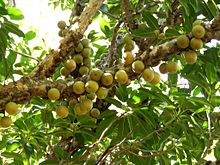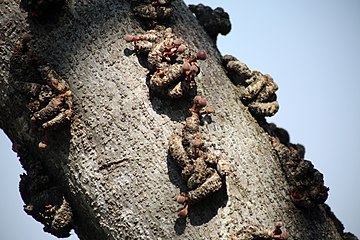Ficus sansibarica: Difference between revisions
No edit summary |
No edit summary Tags: Visual edit Mobile edit Mobile web edit Advanced mobile edit |
||
| (4 intermediate revisions by 3 users not shown) | |||
| Line 1: | Line 1: | ||
{{Short description|Species of tree}} |
|||
{{Italic title}} |
|||
{{Speciesbox |
|||
{{taxobox |
|||
|name = Knobbly fig |
|name = Knobbly fig |
||
|image = Ficus sansibarica, c, Olifants.jpg |
|image = Ficus sansibarica, c, Olifants.jpg |
||
|image2 = Ficus sansibarica, met vye, Olifants, a.jpg |
|image2 = Ficus sansibarica, met vye, Olifants, a.jpg |
||
|image2_caption = The nominate subsp. in the [[Kruger National Park|Kruger Park]] |
|image2_caption = The nominate subsp. in the [[Kruger National Park|Kruger Park]] |
||
| ⚫ | |||
|regnum = [[Plantae]] |
|||
| ⚫ | |||
|unranked_divisio = [[Angiosperms]] |
|||
|unranked_classis = [[Eudicots]] |
|||
|unranked_ordo = [[Rosids]] |
|||
|ordo = [[Rosales]] |
|||
|familia = [[Moraceae]] |
|||
|genus = ''[[Ficus]]'' |
|||
|species = '''''F. sansibarica''''' |
|||
| ⚫ | |||
| ⚫ | |||
|synonyms = |
|synonyms = |
||
* ''F. brachylepis'' <small>Welw. ex Hiern</small> |
* ''F. brachylepis'' <small>Welw. ex Hiern</small> |
||
* ''F. delagoensis'' <small>T. R. Sim</small> |
* ''F. delagoensis'' <small>T. R. Sim</small> |
||
* ''F. gossweileri'' <small>Hutch.</small><ref name=kcp/> |
* ''F. gossweileri'' <small>Hutch.</small><ref name = kcp/> |
||
* ''F. langenburgii'' <small>Warb.</small> |
* ''F. langenburgii'' <small>Warb.</small> |
||
* ''F. ugandensis'' <small>Hutch.</small> |
* ''F. ugandensis'' <small>Hutch.</small> |
||
* ''F. zanzibarica'' <small>Boeck. ex Engl.</small><ref name=tpl>{{cite web |title=''Ficus sansibarica'' Warb. |url=http://www.theplantlist.org/tpl/record/kew-2812180 |work=The Plant List | series = Version 1 | year = 2010 |accessdate=5 July 2013 }}</ref> |
* ''F. zanzibarica'' <small>Boeck. ex Engl.</small> |
||
|synonyms_ref = <ref name = tpl>{{cite web |title = ''Ficus sansibarica'' Warb. |url = http://www.theplantlist.org/tpl/record/kew-2812180 |work = The Plant List | series = Version 1 | year = 2010 |accessdate = 5 July 2013 }}</ref> |
|||
}} |
}} |
||
The ''' |
The '''Ficus sansibarica''', known as '''knobbly fig''', is an African species of [[cauliflory|cauliflorous]] [[Ficus|fig]]. It is named after [[Zanzibar]], where [[Franz Stuhlmann]] discovered it in 1889.<ref name=plantz>{{cite web | last=Mtsweni | first=Patrick | title=''Ficus sansibarica'' Warb. | url=http://www.plantzafrica.com/plantefg/ficussansi.htm | work=PlantZAfrica.com | publisher=SANBI | accessdate=24 July 2013}}</ref> They often begin life as [[epiphyte]]s, which assume a strangling habit as they develop.<ref name="fern">{{cite web |last1=Fern |first1=Ken |title=''Ficus sansibarica'' Warb. Moraceae |url= http://tropical.theferns.info/viewtropical.php?id=Ficus+sansibarica |website=Tropical Plants Database | date = 2019 |publisher= tropical.theferns.info |accessdate=31 May 2019}}</ref> They regularly reach 10 m, but may grow up to 40 m tall as forest stranglers.<ref name=kcp>{{cite book |last=Palgrave |first=K.C. |title=Trees of Southern Africa |year=1984 |publisher=Struik |location=Cape Town |isbn=0-86977-081-0 |pages=114–115}}</ref> |
||
==Range and habitat== |
==Range and habitat== |
||
| Line 42: | Line 35: | ||
==Subspecies and status== |
==Subspecies and status== |
||
* ''F. s.'' subsp. ''sansibarica'' – East Africa: southern [[Kenya]], [[Tanzania]], [[Malawi]], [[Zambia]], northern [[Botswana]], [[Zimbabwe]], [[Mozambique]], northeastern [[South Africa]] and [[ |
* ''F. s.'' subsp. ''sansibarica'' – East Africa: southern [[Kenya]], [[Tanzania]], [[Malawi]], [[Zambia]], northern [[Botswana]], [[Zimbabwe]], [[Mozambique]], northeastern [[South Africa]] and [[Eswatini]] |
||
* ''F. s.'' subsp. ''macrosperma'' <small>(Warb. ex Mildbr. & Burret) C.C.Berg</small> – West and Central Africa: [[Senegal]] to [[Democratic Republic of the Congo|DRC]], [[Uganda]] and [[Angola]] |
* ''F. s.'' subsp. ''macrosperma'' <small>(Warb. ex Mildbr. & Burret) C.C.Berg</small> – West and Central Africa: [[Senegal]] to [[Democratic Republic of the Congo|DRC]], [[Uganda]] and [[Angola]] |
||
The species is deemed critically endangered in |
The species is deemed critically endangered in Eswatini, where most are located in proposed [[sugar cane]] expansion areas near [[Sihoye]].<ref>{{cite web |title=SABONET Report No. 38 |url=http://www.sabonet.org.za/downloads/35_swaziland_tree_atlas/f.swazi.ficus-rosaceae.pdf |page=119 |work=Moraceae |accessdate=7 July 2013 |url-status=dead |archiveurl= https://web.archive.org/web/20110812205130/http://www.sabonet.org.za/downloads/35_swaziland_tree_atlas/f.swazi.ficus-rosaceae.pdf |archivedate=12 August 2011 }}</ref> On [[Inhaca Island]] however, it is held sacred by most communities, and is scrupulously protected.<ref name=plantz/> |
||
==Gallery== |
==Gallery== |
||
<gallery mode=packed heights=160 style="font-size:100%; line-height:130%"> |
<gallery mode="packed" heights="160" style="font-size:100%; line-height:130%"> |
||
Knob Fig Tree (Ficus sansibarica) (11498807685).jpg|Foliage |
Knob Fig Tree (Ficus sansibarica) (11498807685).jpg|Foliage |
||
Knobby fig (Ficus sansibarica), Kruger National Park, South Africa (29208468275).jpg|Figs on wart-like branchlets |
Knobby fig (Ficus sansibarica), Kruger National Park, South Africa (29208468275).jpg|Figs on wart-like branchlets |
||
| Line 66: | Line 59: | ||
[[Category:Trees of Africa]] |
[[Category:Trees of Africa]] |
||
[[Category:Afrotropical realm flora]] |
[[Category:Afrotropical realm flora]] |
||
[[Category:Flora of |
[[Category:Flora of Kenya]] |
||
[[Category:Flora of |
[[Category:Flora of Malawi]] |
||
[[Category:Flora of |
[[Category:Flora of Mozambique]] |
||
[[Category: |
[[Category:Flora of the Northern Provinces]] |
||
[[Category:Flora of Tanzania]] |
|||
[[Category:Flora of Zimbabwe]] |
|||
[[Category:Plants described in 1894]] |
[[Category:Plants described in 1894]] |
||
Latest revision as of 08:12, 3 April 2022
| Knobbly fig | |
|---|---|

| |

| |
| The nominate subsp. in the Kruger Park | |
| Scientific classification | |
| Kingdom: | Plantae |
| Clade: | Tracheophytes |
| Clade: | Angiosperms |
| Clade: | Eudicots |
| Clade: | Rosids |
| Order: | Rosales |
| Family: | Moraceae |
| Genus: | Ficus |
| Species: | F. sansibarica
|
| Binomial name | |
| Ficus sansibarica Warb. 1894
| |
| Synonyms[2] | |
| |
The Ficus sansibarica, known as knobbly fig, is an African species of cauliflorous fig. It is named after Zanzibar, where Franz Stuhlmann discovered it in 1889.[3] They often begin life as epiphytes, which assume a strangling habit as they develop.[4] They regularly reach 10 m, but may grow up to 40 m tall as forest stranglers.[1]
Range and habitat
[edit]It occurs in the African tropics and subtropics from coastal elevations to 900 m above sea level.[5] The nominate subspecies has an easterly distribution, but extends westwards up the Zambezi Valley.[6]
They are found in coastal, riverine and evergreen forests or woodland, and in miombo woodlands. They are locally cultivated in parks,[6] villages[4] or bush camps. They prefer deep sandy soil and often start life as a strangler.[7][8] The pollinating wasp is Courtella armata.[5]
Description
[edit]The light grey bark is fairly smooth, though lumpy and folded.[1] The smooth leaves are up to 13 cm long and oblong-obovate.[8] They have parallel sides and are carried on slender petioles.[1]
The large (up to 5 cm), bitter-tasting figs appear in groups of 2 or 3 during the summer months.[1] They are cauliflorous, growing on the characteristic wart-like, leafless branchlets on the trunk and main branches (i.e. old wood).[7]
F. chirindensis of the forests of southeastern Zimbabwe and adjacent Mozambique is similar, but has the leaves more oval, often has buttress roots,[7] and bears the small (1.5 cm) figs in stalked pairs on second year branches.[1]
Uses
[edit]The raw figs are used for food, and are locally believed to promote fertility. Stems are torn apart to obtain fibers for basket weaving.[4] Locally it is also deemed sacred.
Subspecies and status
[edit]- F. s. subsp. sansibarica – East Africa: southern Kenya, Tanzania, Malawi, Zambia, northern Botswana, Zimbabwe, Mozambique, northeastern South Africa and Eswatini
- F. s. subsp. macrosperma (Warb. ex Mildbr. & Burret) C.C.Berg – West and Central Africa: Senegal to DRC, Uganda and Angola
The species is deemed critically endangered in Eswatini, where most are located in proposed sugar cane expansion areas near Sihoye.[9] On Inhaca Island however, it is held sacred by most communities, and is scrupulously protected.[3]
Gallery
[edit]-
Foliage
-
Figs on wart-like branchlets
-
Figs carried on spurs
References
[edit]- ^ a b c d e f Palgrave, K.C. (1984). Trees of Southern Africa. Cape Town: Struik. pp. 114–115. ISBN 0-86977-081-0.
- ^ "Ficus sansibarica Warb". The Plant List. Version 1. 2010. Retrieved 5 July 2013.
- ^ a b Mtsweni, Patrick. "Ficus sansibarica Warb". PlantZAfrica.com. SANBI. Retrieved 24 July 2013.
- ^ a b c Fern, Ken (2019). "Ficus sansibarica Warb. Moraceae". Tropical Plants Database. tropical.theferns.info. Retrieved 31 May 2019.
- ^ a b Van Noort; et al. "Ficus sansibarica sansibarica Warburg 1894". Figweb. iziko museums. Archived from the original on 30 November 2012. Retrieved 7 January 2012.
- ^ a b Berg, C. C. (1991). "Ficus sansibarica subsp. sansibarica [family MORACEAE]". Flora Zambesiaca. 9 (6). JSTOR Global Plants: 13. Retrieved 31 May 2019.
- ^ a b c Van Wyk, Braam; et al. (1997). Field Guide to the Trees of Southern Africa. Cape Town: Struik. p. 78. ISBN 1-86825-922-6.
- ^ a b Palmer, Eve (1977). A Field Guide to the Trees of Southern Africa. London, Johannesburg: Collins. pp. 89–90. ISBN 0-620-05468-9.
- ^ "SABONET Report No. 38" (PDF). Moraceae. p. 119. Archived from the original (PDF) on 12 August 2011. Retrieved 7 July 2013.
External links
[edit]- Natureswow blogspot.com: Knobby Fig (Ficus sansibarica)
 Media related to Ficus sansibarica at Wikimedia Commons
Media related to Ficus sansibarica at Wikimedia Commons



